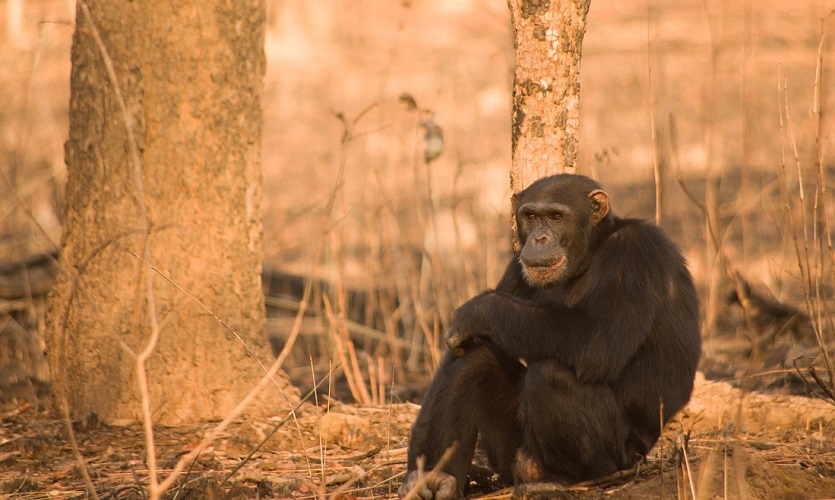Great apes predicted to lose 90% of African homelands, study finds

A ‘triple-whammy’ of climate change, land-use change and human population growth is set to decimate the habitats of Africa’s great apes – gorillas, chimpanzees and bonobos – over the coming 30 years.
Conservation biologists led by the Wildlife Conservation Society and Liverpool John Moores University predict the apes will lose an astonishing 85% minimum of their range and as much as 94% of their current ‘home lands.’
All African great apes are classified either as Endangered or Critically Endangered in the IUCN Red List of Threatened Species.
Dr Joana Carvalho of Liverpool John Moores University, lead author of the study said: “It’s a perfect storm for many of our closest genetic relatives many of which are flagship species for conservation efforts within Africa and worldwide.
“If we add climate change to the current dynamics impacting territory loss, the picture looks devastating.”
20 years of data
The study, published on June 7 in the journal Diversity and Distributions, looked painstakingly at data collected for the IUCN SSC A.P.E.S. database on population status, threats and conservation for several hundred sites over a 20-year period.
It then modelled future joint effects of climate, land-use, and human population changes across African ape ranges for the year 2050 under best- and worst-case scenarios, best being a gradual lowering of carbon emissions towards 2050 IPCC targets and ‘worst’ assuming that emissions continue to increase unchecked.
Under the best-case scenario, the authors predict that great apes will lose 85% of their range, of which 50% will be in national parks and other areas protected by legislation. Under the worst-case scenario, they predict a 94 percent loss, 39% of which will be in areas that are protected.
The study, which involves 60 organisations including The Jane Goodall Institute and the Born Free Foundation, says the apes’ survival will depend much on how, like humans, they are able to adapt.
To the mountains
For instance, while most great ape species prefer lowland habitats, climate change will render some lowlands less suitable – warmer, drier, perhaps less food available – making uplands more attractive.
If apes are able to physically move from the lowlands to the mountains in time, they may be able to survive, and even increase their range.
Fiona Maisels of the Wildlife Conservation Society, and co-author, said: “As climate change forces the different types of vegetation to essentially shift uphill, it means that all animals – not only great apes – that depend on particular habitat types will be forced to move uphill or become locally extinct.
“And when the hills are low, many species, will not be able go higher than the land allows, and huge numbers of animals and plants will simply vanish.”
Global responsibility
They say that efforts to maintain connectivity between suitable future habitats will be crucial for the survival of African apes and urge conservation planners to integrate land-use planning and climate change mitigation measures into government policy of great ape range countries.
Hjalmar Kuehl, from iDiv in Leipzig, Germany, and senior author, said: “There must be global responsibility for stopping the decline of great apes. Global consumption of natural resources extracted from ape range countries is a major driver of great ape decline. All nations benefitting from these resources have a responsibility to ensure a better future for great apes, their habitats and the people living therein by developing more sustainable economies.”
The study involved over 60 co-authors from academic and non-academic organizations and government agencies, including Antwerp Zoo Society, Born Free Foundation, Chimbo Foundation, Conservation Society of Sierra Leone, Environment and Rural Development Foundation, Fauna & Flora International, Frankfurt Zoological Society, Jane Goodall Institute, Rio Tinto, Royal Society for the Protection of Birds, San Diego Zoo Global, Sekakoh Organisation, Sierra Rutile Limited, Tacugama Chimpanzee Sanctuary, The Biodiversity Consultancy, West African Primate Conservation Action, Wild Chimpanzee Foundation, Wildlife Conservation Society (WCS), and World Wide Fund for Nature.
-Predicting range shifts of African apes under global change scenarios is published June 7, 2021 in Diversity and Distributions and authored by Carvalho JS, Graham B, Bocksberger G, Maisels F, Williamson EA, Wich S, Sop T, Amarasekaran B, Barca B, Barrie A, Bergl RA, Boesch C, Boesch H, Brncic TM, Buys B, Chancellor R, Danquah E, Doumbé OA, Le-Duc SY, Galat-Luong A, Ganas J, Gatti S, Ghiurghi A, Goedmakers A, Granier N, Hakizimana D, Haurez B, Head J, Herbinger I, Hillers A, Jones S, Junker J, Maputla N, Manasseh EN, McCarthy M, Molokwu-Odozi M, Morgan BJ, Nakashima Y, N’Goran PK, Nixon S, Nkembi L, Normand E, Nzooh LDZ, Olson SH, Payne L, Petre CA, Piel AK, Pintea L, Plumptre AJ, Rundus A, Serckx A, Stewart FA, Sunderland-Groves J, Tagg N, Todd A, Vosper A, Wenceslau JFC, Wessling EG, Willie J, & Kühl HS (2021).


